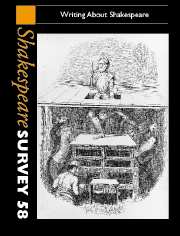Book contents
- Frontmatter
- Having Our Will: Imagination in Recent Shakespeare Biographies
- Toward a New Biography of Shakespeare
- Jonson, Shakespeare and the Exorcists
- ‘Lending soft audience to my sweet design’: Shifting Roles and Shifting Readings of Shakespeare’s ‘A Lover’s Complaint’
- ‘Armed at point exactly’: The Ghost in Hamlet
- Writing About Motive: Isabella, the Duke and Moral Authority
- Writing Performance: How to Elegize Elizabethan Actors
- Elizabeth Montagu: ‘Shakespear’s poor little Critick’?
- Rewriting Lear’s Untender Daughter: Fanny Price as a Regency Cordelia in Jane Austen’s Mansfield Park
- The Prequel as Palinode: Mary Cowden Clarke’s Girlhood of Shakespeare’s Heroines
- Shakespeare Among the Workers
- Virginia Woolf Reads Shakespeare: Or, her Silence on Master William
- Shakespeare and the Invention of the Epic Theatre: Working with Brecht
- Dramatizing the Dramatist
- Shakespeare in Drama Since 1990: Vanishing Act
- Writing about [Shakespearian] performance
- Shakespeare and the Prospect of Presentism
- Writing Shakespeare in the Global Economy
- The ‘Complexion’ of Twelfth Night
- Translation as Appropriation: Vassilis Rotas, Shakespeare and Modern Greek
- How Old Were Shakespeare’s Boy Actors?
- Mistress Tale Porter and the Triumph of Time: Slander and Old Wives’ Tales in The Winter’s Tale
- Shakespeare Performances in Ireland, 2002–2004
- Shakespeare Performances in England, 2004
- Professional Shakespeare Productions in the British Isles January–December 2003
- The Year's Contributions to Shakespearian Study 1 Critical Studies
- 2 Shakespeare in Performance
- 3 Editions and Textual Studies
- Books Received
- Index
2 - Shakespeare in Performance
Published online by Cambridge University Press: 28 March 2007
- Frontmatter
- Having Our Will: Imagination in Recent Shakespeare Biographies
- Toward a New Biography of Shakespeare
- Jonson, Shakespeare and the Exorcists
- ‘Lending soft audience to my sweet design’: Shifting Roles and Shifting Readings of Shakespeare’s ‘A Lover’s Complaint’
- ‘Armed at point exactly’: The Ghost in Hamlet
- Writing About Motive: Isabella, the Duke and Moral Authority
- Writing Performance: How to Elegize Elizabethan Actors
- Elizabeth Montagu: ‘Shakespear’s poor little Critick’?
- Rewriting Lear’s Untender Daughter: Fanny Price as a Regency Cordelia in Jane Austen’s Mansfield Park
- The Prequel as Palinode: Mary Cowden Clarke’s Girlhood of Shakespeare’s Heroines
- Shakespeare Among the Workers
- Virginia Woolf Reads Shakespeare: Or, her Silence on Master William
- Shakespeare and the Invention of the Epic Theatre: Working with Brecht
- Dramatizing the Dramatist
- Shakespeare in Drama Since 1990: Vanishing Act
- Writing about [Shakespearian] performance
- Shakespeare and the Prospect of Presentism
- Writing Shakespeare in the Global Economy
- The ‘Complexion’ of Twelfth Night
- Translation as Appropriation: Vassilis Rotas, Shakespeare and Modern Greek
- How Old Were Shakespeare’s Boy Actors?
- Mistress Tale Porter and the Triumph of Time: Slander and Old Wives’ Tales in The Winter’s Tale
- Shakespeare Performances in Ireland, 2002–2004
- Shakespeare Performances in England, 2004
- Professional Shakespeare Productions in the British Isles January–December 2003
- The Year's Contributions to Shakespearian Study 1 Critical Studies
- 2 Shakespeare in Performance
- 3 Editions and Textual Studies
- Books Received
- Index
Summary
Of course you can’t judge a book by its cover. But a pile of books on Shakespeare in performance encourages this kind of snapshot approach, and the semiotics of cover illustrations – like the semiotics of much recent performance – reveals an instinct towards a strongly framed visual concept. If we cannot judge the books by their covers, we can certainly answer certain questions by looking at them. Is Shakespeare in performance cool? Yes, says the cover to the achingly hip Shakespeare, the Movie, II (edited by Richard Burt and Lynda E. Boose), which shows us Ethan Hawke as moody rich boy Hamlet walking the streets of New York, his torso crossed with an urban bag strap, an ethnic knitted hat pulled down on his head, sunglasses and a downcast look of stylish alienation. Maybe, says Sarah Hatchuel’s Shakespeare, from Stage to Screen, with a bearded Branagh, dressed in double breasted tunic and sword by his side, looking through the camera on the set of Much Ado About Nothing: it’s film, so modern, but it has swords in it, so it’s also old. No, says the uninspiring cover to Jonathan Holmes’s Merely Players, which manages to suggest that his fascinating analysis of a range of actors’ accounts of their work are the equivalent of the jacket’s Jacobethan burgundy flock wallpaper. Is the field all olde-worlde doublet and hosery? No, says Cynthia Marshall’s Shakespeare in Production: As You Like It, with its cut-out from Cheek by Jowl’s all-male production where an arch Celia strokes Rosalind’s flank. Not quite, says Players of Shakespeare 6, in which a sumptuously dressed king complete with crown who stands by his queen, looking stageleft in consternation, is played by a black actor.
- Type
- Chapter
- Information
- Shakespeare Survey , pp. 334 - 342Publisher: Cambridge University PressPrint publication year: 2005

